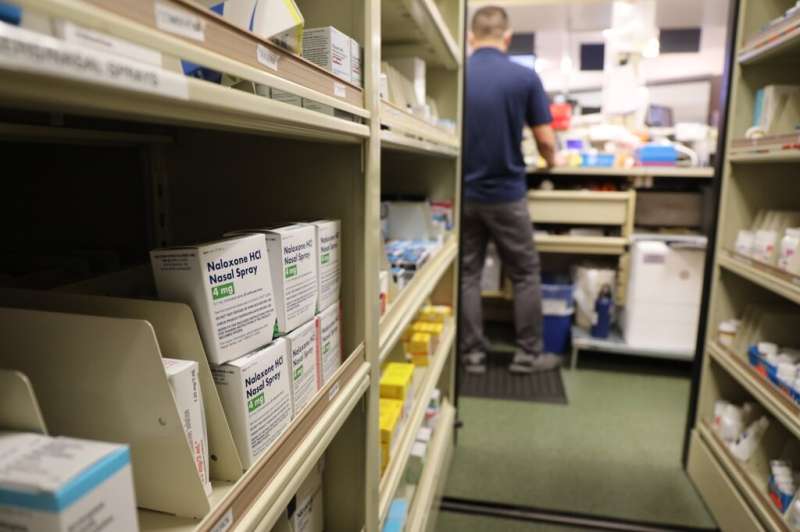This article has been reviewed according to Science X's editorial process and policies. Editors have highlighted the following attributes while ensuring the content's credibility:
fact-checked
peer-reviewed publication
trusted source
proofread
Poison center sees dramatic increase in young children exposed to fentanyl

The Oregon Poison Center at Oregon Health & Science University is reporting a dramatic increase in cases of young children exposed to fentanyl. The poison center managed 16 cases of illicit fentanyl exposure in children younger than 6 years old in 2023, an increase from just 2 in 2021 and 0 in 2020.
This trend is mirrored nationally when researchers examined data from all U.S. Poison Centers. Just 10 cases of fentanyl exposures in children under 6 years old were reported to U.S. Poison Centers in 2016. By 2020 that number jumped to 120, and by 2023, U.S. Poison Centers managed 539 cases of illicit fentanyl exposure in children under 6 years old—a 449% increase in 3 years and a 5,390% increase since 2016.
The findings were published today in a perspective in the New England Journal of Medicine.
"It is imperative that the community provides resources to end the fentanyl epidemic, and that people who use illicit drugs secure them from children by using opaque, child-resistant, lockable containers," says Robert Hendrickson, M.D., lead author of the study, medical director of the Oregon Poison Center at OHSU, and professor of emergency medicine in the OHSU School of Medicine.
"We are extremely concerned about what we are seeing in the community and across the nation, and will continue to bring the issue to the forefront to raise awareness about how to prevent unintentional exposures among children."
Risks in the home
Researchers from OHSU studied the relationship between unintentional pediatric exposures to illicit fentanyl and the availability of fentanyl in Oregon starting in 2016. They examined regional poison center data and drug seizure data from the U.S. Drug Enforcement Administration, and determined that pediatric fentanyl exposures increased in relation to the number of pills seized.
National data revealed that most children exposed to fentanyl experienced severe effects including losing consciousness, stopping breathing and brain injury. Naloxone was administered to 63% of the children. Most children were 2 years of age or younger.
The study found that 82% of pediatric unintentional exposures to illicit fentanyl occurred in the child's home. Among Oregon children, this number was even higher: 93% of the children were exposed in their homes, highlighting the need for education and awareness about preventing unintentional pediatric drug exposures where children live.
Prevent opioid overdoses
When prescribed by a doctor, fentanyl can be given as a shot, a patch that is put on a person's skin, or as lozenges that are used like cough drops. Illegally manufactured fentanyl is made in labs and pressed into small blue pills meant to mimic oxycodone tables. Unlike prescription pills, the amount of fentanyl in these counterfeit pills may vary from pill to pill and the amount in a single pill can cause severe symptoms in most children.
Whether prescription or illicit, the Oregon Poison Center offers important tips when it comes to fentanyl:
- Lock up medication. Parents of young children should ensure all medicine, drugs and other potentially poisonous substances are kept up high and out of reach. Locked up is best: Simple measures like using a cabinet lock or medicine lock box can have a big impact. These substances must be locked up after every use.
- Teach young children not to put anything in their mouths unless a trusted adult says it's okay. When visiting another household, make sure medicine and drugs are out of reach or locked up.
- Carry naloxone. People who use illicit drugs or whose loved ones use illicit drugs should take precautions against overdoses, including carrying multiple doses of naloxone, the opioid reversal drug. Naloxone is available at pharmacies in Oregon without a prescription.
- People who use illicit fentanyl should be aware of the risk to children and use lock boxes or opaque, lockable, portable bags to store fentanyl or any potentially dangerous drug.
Know the signs of overdose. Signs that someone is experiencing an opioid overdose include:
- Small, constricted "pinpoint" pupils
- Pale, bluish skin
- Vomiting or foaming at the mouth
- Slow, shallow breathing
- Appearing sleepy or losing consciousness.
Call 9-1-1 right away if someone is unconscious, not breathing, or if naloxone has been given. Medical experts at the Oregon Poison Center can help if someone is experiencing unwanted symptoms after taking pills or using illicit substances.
The Oregon Poison Center is also available to provide medical advice and information to the public, and to provide medical consultation for health care workers with patients who may have been exposed to fentanyl.
More information: Courtney Temple et al, Increasing Exposure of Young Children to Illicit Fentanyl in the United States, New England Journal of Medicine (2024). DOI: 10.1056/NEJMc2313270


















